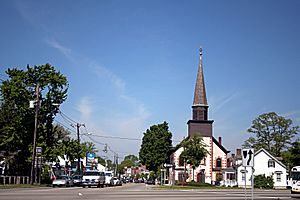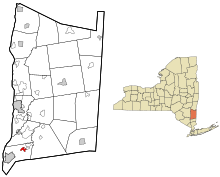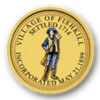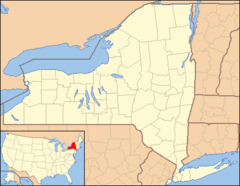Fishkill, New York facts for kids
Quick facts for kids
Fishkill, New York
|
||
|---|---|---|

|
||
|
||

Location of Fishkill, New York
|
||
| Country | United States | |
| State | New York | |
| County | Dutchess | |
| Town | Fishkill | |
| Government | ||
| • Type | Village Board of Trustees | |
| Area | ||
| • Total | 0.84 sq mi (2.16 km2) | |
| • Land | 0.83 sq mi (2.15 km2) | |
| • Water | 0.00 sq mi (0.01 km2) | |
| Elevation | 220 ft (67 m) | |
| Population
(2020)
|
||
| • Total | 2,166 | |
| • Density | 2,603.37/sq mi (1,005.44/km2) | |
| Time zone | UTC-5 (Eastern (EST)) | |
| • Summer (DST) | UTC-4 (EDT) | |
| ZIP code |
12524
|
|
| Area code(s) | 845 | |
| FIPS code | 36-25967 | |
| GNIS feature ID | 0977519 | |
Fishkill is a small village in Dutchess County, New York, United States. It is located within the larger town of Fishkill. The village sits in the eastern part of the town.
You can find Fishkill on U.S. Route 9, just north of Interstate 84. NY 52 is its main street. Fishkill is part of a larger area that includes cities like Poughkeepsie and Newburgh. It also connects to the even bigger New York metropolitan area. Interestingly, the very first U.S. Post Office in New York state was set up here by Samuel Loudon.
Contents
History of Fishkill Village
Early Beginnings and Name Origin
Fishkill is located on land that once belonged to the Wappinger people. In 1685, this area became part of a large land grant called the Rombout Patent. This grant was given to Francis Rombouts, Gulian VerPlanck, and Stephanus Van Cortlandt from New Amsterdam (which is now New York City).
The name "Fishkill" comes from two Dutch words. vis means "fish" and kil means "stream" or "creek". So, Fishkill means "fish creek." Dutch immigrants started settling here in 1714.
A Crossroads in Early America
In the 1700s and 1800s, Fishkill was a very important crossroads for travel. The Queen's Highway, which connected Albany to New York City, crossed paths with a main route from New England to the Hudson River. This made Fishkill a busy place. Some of the first people to live in the village area were Johannes Ter Boss and Henry Rosecrance.
Fishkill During the American Revolution
During the American Revolution, Fishkill played a big role. When the British took over New York City, a printer named Samuel Loudon moved his business to Fishkill. He opened the first post office in New York state here. Loudon also kept printing his revolutionary newspaper, The New York Packet and The American Advertiser.
In May 1776, the third New York Provincial Congress met in Fishkill. The village became one of the largest military camps for the American army during the war. Even General Washington's helper, Alexander Hamilton, lived here for a time. Trinity Church, built in 1760, was used as a hospital for soldiers. The Dutch Reformed church served as a military prison. An American spy named Enoch Crosby was briefly held there before he was allowed to escape.
Growth and Changes in the Village
In 1871, work began on a new schoolhouse on Church Street. The land for the school used to be a pasture for the pastor's cow. In 1876, a large fire destroyed many of the old wooden buildings in the village. These were later replaced with stronger brick buildings.
The Name "Fishkill" and Its Meaning
In 1996, an animal rights group suggested that Fishkill should change its name. They thought the name sounded like it promoted violence against fish. However, the town explained that the name is not about violence. It comes from the Dutch word kil, meaning "creek." Many other places in New York also have "Kill" in their names, like the Catskills and Beaver Kill. These names also refer to creeks, not to harming animals.
Geography of Fishkill
Fishkill village covers about 2.3 square kilometers (0.84 square miles) of land. According to the 2010 census, the village had a population of 2,171 people.
Population and People
| Historical population | |||
|---|---|---|---|
| Census | Pop. | %± | |
| 1870 | 737 | — | |
| 1880 | 682 | −7.5% | |
| 1890 | 745 | 9.2% | |
| 1900 | 589 | −20.9% | |
| 1910 | 516 | −12.4% | |
| 1920 | 479 | −7.2% | |
| 1930 | 553 | 15.4% | |
| 1940 | 720 | 30.2% | |
| 1950 | 841 | 16.8% | |
| 1960 | 1,033 | 22.8% | |
| 1970 | 913 | −11.6% | |
| 1980 | 1,555 | 70.3% | |
| 1990 | 1,957 | 25.9% | |
| 2000 | 1,735 | −11.3% | |
| 2010 | 2,171 | 25.1% | |
| 2020 | 2,166 | −0.2% | |
| U.S. Decennial Census | |||
In 2000, there were 1,735 people living in Fishkill. The population has changed over the years, as shown in the table above. Most people in the village are White (93.72%). There are also people who are African American, Native American, Asian, and from other backgrounds. About 6% of the population is Hispanic or Latino.
Many residents have family roots from places like Italy, Ireland, Germany, and England. In 2000, about 14% of households had children under 18. The average age of people in Fishkill was 48 years old.
Getting Around Fishkill
Roads and Highways
U.S. Route 9 goes north from Fishkill to places like Wappingers Falls (5 miles away) and Poughkeepsie (12 miles away). It also goes south to Peekskill (19 miles away).
New York State Route 52 heads west to Beacon (5 miles) and east to the Taconic State Parkway (7 miles). Interstate 84 is just 1 mile south of the village. This highway can take you to Newburgh (7 miles west) or Danbury, Connecticut (31 miles southeast). New York City is about 70 miles south.
Public Transportation
Fishkill is served by local bus routes. These routes are called "A," "B," and "F," and they are run by Dutchess County Public Transit.
Major Employer
The biggest employer in Fishkill village is Gap Inc., a well-known clothing company. Their large distribution center opened in 2000 and expanded in 2001. In 2014, Gap Inc. announced plans to add many new jobs and invest a lot of money into this center. However, in 2016, a big fire at the Gap distribution center caused hundreds of employees to be out of work. Everyone was safely evacuated from the building.
Notable Person from Fishkill
- William J. Hutchins (1813–1884) was born in Fishkill. He became a very successful businessman and even served as the mayor of Houston, Texas.
See also
 In Spanish: Fishkill (villa) para niños
In Spanish: Fishkill (villa) para niños






